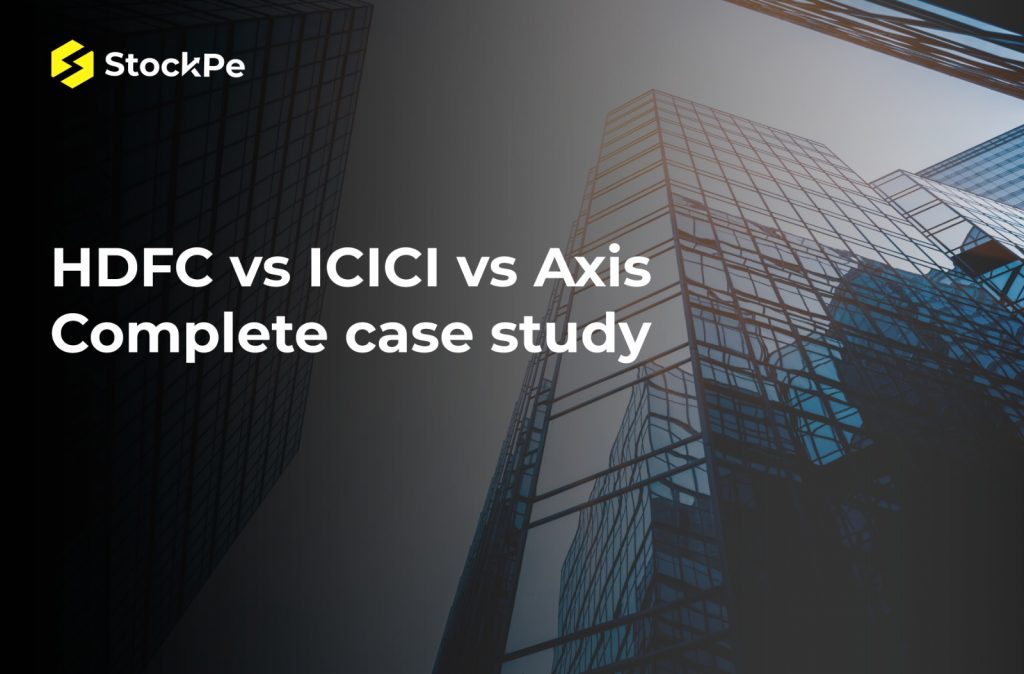HDFC, ICICI, and Axis Banks are three of India’s biggest private sector banks. These banks are known for their state of art services and products, customer-centric approach, and robust business models. Two of the three banks, i.e., HDFC and ICICI, also have been placed under Domestically systematically important banks (D-SIBs) by the RBI in the past years. In this blog, we see an overview of these private banks and compare them based on their financial performance, customer base, and business models.

About HDFC Bank:
HDFC is India’s biggest private sector bank, with total assets of ₹ 25.3 lakh crores as of 2023. The bank was established in 1994, post-LPG reforms of 1991, and it became the largest issuer of credit cards in the country. HDFC Bank has a vast network of branches and ATMs. It offers its customers a range of banking services and products. Its MSPs are a strong customer-centric approach, efficient services, and technological innovation.
HDFC Bank’s Financial Performance:
HDFC Bank is the most profitable bank in India. For the financial year (FY) of 22-23, the bank disclosed a net profit of a staggering ₹ 44,108 crore, an increase of more than 19% over ₹ 36,961 crores in FY22. The bank’s revenue for the same period was ₹. 87,515 crore, the most among the three banks. HDFC Bank’s net interest margin (NIM) was 4.1% in the same period, one of the highest among banks of India.
HDFC Bank’s Customer Base:
HDFC Bank has the most extensive customer base among the three banks(Only behind SBI overall), with over 6.8 crore customer base as of April 4, 2022. HDFC Bank has 6,342 branches across India and around 21,683 banking outlets. HDFC Bank has a strong presence, primarily in urban areas, and with the Indian government’s push towards financial inclusion, the bank has been expanding its operations in rural areas.
HDFC Bank’s Business Model:
HDFC Bank’s business model is based on a solid customer-centric approach, efficient operations, and technological innovation. The bank’s business model is simple. It offers various banking services and products, like retail banking, corporate banking, and investment banking. HDFC Bank has also invested heavily in digital technology, enabling it to offer services like Internet banking, mobile banking, and digital wallets.
About ICICI Bank:
Behind HDFC, ICICI Bank is the second largest private bank in India. Like HDFC, It was established in 1994 and has since become one of the most successful banks in India. Its total capital and assets value is ₹19.58 lakh crores (US$250 billion) as of 2023. ICICI Bank has a vast network of branches and ATMsicic and offers its customers a range of banking services and products. The bank’s business model is based on a solid customer-centric approach, efficient operations, and technological innovation.
ICICI Bank’s Financial Performance:
Recently, ICICI Bank was notified of a net profit of ₹ 9,122 crore for the March ending quarter of 2023, up 30% year-on-year from the same quarter of the previous financial year of ₹ 7018.71 crore.
ICICI Bank’s Customer Base:
With over 52 million customers, ICICI has become a household name for banking in India. The bank has a strong presence primarily in urban areas, and in recent times it’s expanding its business in tier 3 cities as well as rural areas.
ICICI Bank’s Business Model:
ICICI Bank’s business model is similar to that of HDFC Bank, based on a solid customer-centric approach, efficient operations, and technological innovation. The bank offers all types of banking services and products, including retail banking, corporate banking, and investment banking. ICICI Bank has been a frontrunner in investing heavily in digital technology, enabling it to offer services like mobile banking apps and digital wallets.
About Axis Bank:
Axis Bank is one of the major players in the private sector of the banking system in India. It was established in 1993 and gradually it cemented its position as one of the fastest-growing banks in the country. Axis Bank has many branches and ATMs and offers its customers a range of banking services and products. The bank’s business model is based on a customer-centric approach, efficient operations, and innovative offers.
Axis Bank’s Financial Performance:
Axis Bank has consistently grown with a 5-year CAGR (2017-18 to 2022-23) of 14% each in Total Assets & Advances and 16% in Deposits. The bank’s NIM was 3.1% in the same period, which is lower than that of HDFC Bank and ICICI Bank.
Axis Bank’s Customer Base:
Axis Bank has a customer base of over 21 million as of 2022. The bank has a strong presence in urban, especially in metropolitans. It has been expanding its operations in semi-urban and rural areas as well. It has also maintained strong positioning in Mobile Banking, where it is among the highest-rated financial apps in the country, with active users of 9 million. (Monthly)
Axis Bank’s Business Model:
Axis Bank’s business model is based on a solid customer-centric approach, efficient operations, and innovative product offerings. The bank offers various banking services and products, corporate banking, including retail banking, and investment banking. Axis Bank has also invested heavily in digital technology, enabling it to offer services like Internet banking, mobile banking, and digital wallets.
Stock Performance: HDFC vs. ICIC vs. Axis
Investors keep wondering about where to invest their money in the financial sector. Investors have closely watched the stocks of the three banks over the past few years. These three banks are considered leaders in the banking industry. Let’s quickly take a closer look at the past stock performance of these three banks.
Performance of HDFC Bank:
HDFC Bank stocks have been one of the most consistent performers in the Indian stock market over the past few years. The bank’s stock has performed well, with the share price increasing steadily over the years. From May 2018 to May 2023, the stock has increased by around 87%. The bank’s strong financial performance, unparalleled services, and efficient operations have helped to drive its stock price higher.
However, HDFC Bank’s stock (same as the other two banks) has also experienced volatility in the past year due to the COVID-19 pandemic. In March 2020, the stock experienced a significant decline due to concerns about the pandemic’s impact on the Indian economy. However, the shares quickly rebounded in 2021 and have been trending upward since then.
Performance of ICICI Bank:
ICICI Bank is another leading private sector bank in India, and its stock has also performed well over the past few years. From May 2018 to May 2023, the stock has increased by around 93%. ICICI has made exponential progress by working on improving its asset quality and reducing its non-performing assets (NPAs) over the past few years, which has helped to drive investors’ confidence in them.
Performance of Axis Bank:
Axis Bank’s stock performance has been more mixed compared to HDFC Bank and ICICI Bank. From May 2018 to May 2023, the stock has increased by around 21%. The bank has faced some challenges with its asset quality and management changes in recent years, affecting investor confidence.
Overall, the past stock performance of HDFC Bank, ICICI Bank, and Axis Bank reflects the overall strength of the Indian banking industry. While HDFC Bank and ICICI Bank have been more consistent performers, Axis Bank has also made progress in improving its financial performance and investing in digital technology. As with any investment ever, past performance does not always guarantee future profits. However, it provides a direction to investors but it is advisable for investors to conduct their own analysis before making investment decisions.
Comparison:
Regarding financial performance, HDFC Bank is the clear winner among the other banks, with the highest net profit and revenue. However, all three banks have a strong customer base and offer various banking services and products. HDFC Bank has the largest customer base, while ICICI Bank and Axis Bank are stretching their operations in semi-urban and rural areas.
Regarding business models, all three banks have a strong customer-centric approach and rely on technological innovation to offer digital banking services. However, HDFC Bank has been more aggressive in investing in technology, focusing more on digital payments and mobile banking.
Lastly!
HDFC, ICICI, and Axis are the leading private sector banks in India. While HDFC Bank has the largest customer base and the best financial performance, ICICI Bank and Axis Bank are also expanding their operations and investing in digital technology. All three banks have a strong customer-centric approach and rely on technological innovation to offer banking services and products to their customers.




